No, I haven’t seen Avatar yet. I haven’t seen Alvin and the Chipmunks: The Squeakquel, either, so this whole endeavor could be a fool’s errand. Still, onward. Favorite films of the year, listed in order seen.
Up
The Hurt Locker
In the Loop
Julia
Inglourious Basterds
District 9
The Informant!
A Serious Man
Anvil!: The Story of Anvil
The Damned United
Two exclamation points. That’s a record.
Cinematic highlight of the year: same as always, baby. Noir City. 2010’s installment is coming up fast.
And a holdover from last year’s list, Thrillers More People Should Have Seen. All currently available on video.
Just Another Love Story. Classic noir elements repurposed and updated in a twisty film from Denmark.
The Limits of Control. Calling Jim Jarmusch’s movie a thriller may be something of a stretch. I’m not sure what happens in it. I’m not sure anything happens in it. Simply allow its beauty to wash over you, though, and you’ll be alright.
The Merry Gentleman. I’m a fan of Michael Keaton’s directorial debut. But it will now always have a special place in my heart. Why? Because it made me big in Canada.
A Perfect Getaway. David Twohy is the last of the old-school genre storytellers (Pitch Black, Below). The slow build-up and the lead character being a screenwriter only add to the meta-fun. If this movie were French, it would be a cult classic praised to the rafters by hipster critics. But because it was filmed in Hawaii and stars recognizable actors like Steve Zahn and Timothy Olyphant, it’s fated to be the best movie nobody saw this year.
Thursday, December 31, 2009
The Good Stuff: Films of 2009
Tuesday, December 29, 2009
The Good Stuff: Books of 2009
I’ll keep the preamble to a minimum. The books are listed in the order I read them. More detailed posts can be found here.
Favorite crime fiction:
Beat the Reaper, Josh Bazell
Safer, Sean Doolittle
American Rust, Philipp Meyer
No More Heroes, Ray Banks
Bury Me Deep, Megan Abbott
Dark Places, Gillian Flynn
The Jerusalem File, Joel Stone
The Ghosts of Belfast, Stuart Neville
Pariah, Dave Zeltserman
Losers Live Longer, Russell Atwood
Favorite not-crime fiction:
How I Became a Famous Novelist, Steve Hely
Hummingbirds, Joshua Gaylord
The Financial Lives of the Poets, Jess Walter
Bonus Categories:
2008 novel that would have been on this year’s list and could have been on last year’s had I read it in time: The Age of Dreaming, Nina Revoyr
2010 novel that would have been on this year’s list and will probably be on next year’s: Print the Legend, Craig McDonald
Favorite novels that were new to me in 2009: The Red Right Hand, Joel Townsley Rogers (1945) and Adios, Scheherazade, Donald E. Westlake (1970). Again, a thousand thanks to Duane Swierczynski for introducing me to the latter.
Favorite non-fiction:
The Complete Game, Ron Darling
Methland, Nick Reding
L.A. Noir, John Buntin
And finally, the best book I read in 2009 regardless of genre or year of publication is Moneyball: The Art of Winning an Unfair Game, by Michael Lewis (2003). I’ll go you one better. This book – about economics, business, mathematics, baseball and life – goes on the short list of the greatest books I’ve ever read, along with Dino, Nick Tosches’ biography of Dean Martin, and The Hardy Boys Detective Handbook. Illustrious company indeed.
Wednesday, December 23, 2009
Miscellaneous: It’s A Shane Black Christmas (Redux)
There I am at my favorite watering hole, talking with the staff, when the subject of Christmas movies is raised.
First suggestion, not made by me: the traditional double-bill of Die Hard and Die Hard II: Die Harder.
Thus giving me the tenor of the conversation. This is not the time, perhaps, to mention Remember the Night and Holiday Affair, two overlooked films (with noir connections!) that Turner Classic Movies has labored to turn into Yuletide staples. Although a mention of Blast of Silence, full of Wenceslas wetwork, might not be out of the question.
So I lobby for my own Christmas favorite, The Ref. And then observe, not for the first time, that the entire oeuvre of Shane Black – Lethal Weapon, The Last Boy Scout, The Long Kiss Goodnight, and Kiss Kiss Bang Bang – is set at the most wonderful time of the year.
Therefore, as you venture out for that last round of shopping, I offer, by popular demand, what has become a VKDC tradition. (“By popular demand” meaning Rosemarie asked, “Why haven’t you posted this yet?” And she did write most of it.) Here, once again, is Shane Black’s 12 Days of Christmas. Record your church group performing this and we’ll post the video here!
Twelve cars exploding
Eleven extras running
Ten tankers skidding
Nine strippers pole-ing
Eight Uzis firing
Seven henchmen scowling
Six choppers crashing
Five silver Glocks
Four ticking bombs
Three hand grenades
Two mortar shells
And a suitcase full of C-4
God bless us, everyone. Or else.
Tuesday, December 22, 2009
Book: Alone, by Loren D. Estleman (2009)
Third consecutive book about Hollywood in one form or another. I don’t plan these things, people. They simply happen.
Any list of crime fiction’s premier stylists would have to include Loren Estleman. His insouciant prose has brightened up many a dark book, but it fizzes like champagne in his lighter tales about Valentino, the UCLA archivist whose business cards read “film detective.”
A rare treasure is dangled before Valentino by a university donor: the only extant print of How Not to Dress, the brief promotional film marking the first screen appearance of Greta Garbo. But before light strikes frame one, Valentino finds himself amidst blackmail and murder. He’s got other problems. A crooked building inspector has rousted him from the movie palace he’s attempting to restore to its former glory, leaving him at the house and the throat of his closest friend and colleague. And there’s his budding romance with an LAPD forensics expert.
Alone is a confection, and a good one. Estleman has struck upon an ingenious method for writing about classic Hollywood in a contemporary setting. I will say that the jabs at current films are out of character and occasionally wrong; Brian De Palma’s name is spelled incorrectly, and Pulp Fiction is misquoted in the author’s afterword. It’s important for curmudgeons to get the details right. Still, it’s a minor quibble. Go. Buy. Read.
Sunday, December 20, 2009
Book: L.A. Noir, by John Buntin (2009)
John Buntin started with a real-world question steeped in fiction: how did the LAPD of L.A. Confidential become the LAPD of Dragnet? Answering it produced a rich, lively work of history that reads like a pulp novel from the era it covers.
L.A. Noir is a joint biography of William H. Parker, the chief who made the department what it is today, and Mickey Cohen, the kind of gangster who could only flourish in Southern California. But it’s also a portrait of what Buntin calls “America’s Most Seductive City” from the 1920s through the Watts riots. Like any first-rate Hollywood production it features a slew of cameos, including Billy Graham and Ben Hecht, Lana Turner and Johnny Stompanato.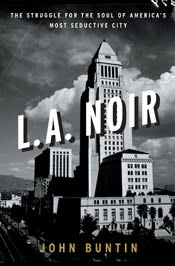 Some of the most interesting material involves Dragnet and how Parker used the show in all its forms to remold the LAPD’s image. It’s hard to overstate Dragnet’s popularity; at one point it was the most watched TV series in America after I Love Lucy while still drawing a huge radio audience. The next step, obviously, was a feature film. At the time of production, the LAPD’s more invasive tactics were being challenged in the courts; in instances where the department couldn’t get permission to place wiretaps, it would simply break into a suspect’s home, install a dictograph, and record conversations that way. Parker offered Dragnet’s Jack Webb a sensational case file to serve as the basis for the film, which ended up defending the techniques then under siege. The 1954 Dragnet movie, by the way, is uncommonly grim and brutal. Even for Jack Webb. It’s kind of great. It’s not currently on video, but it is available via streaming on Netflix.
Some of the most interesting material involves Dragnet and how Parker used the show in all its forms to remold the LAPD’s image. It’s hard to overstate Dragnet’s popularity; at one point it was the most watched TV series in America after I Love Lucy while still drawing a huge radio audience. The next step, obviously, was a feature film. At the time of production, the LAPD’s more invasive tactics were being challenged in the courts; in instances where the department couldn’t get permission to place wiretaps, it would simply break into a suspect’s home, install a dictograph, and record conversations that way. Parker offered Dragnet’s Jack Webb a sensational case file to serve as the basis for the film, which ended up defending the techniques then under siege. The 1954 Dragnet movie, by the way, is uncommonly grim and brutal. Even for Jack Webb. It’s kind of great. It’s not currently on video, but it is available via streaming on Netflix.
If you’re a fan of Chandler, Chinatown, or Ellroy, L.A. Noir is essential reading. It’s one of the best books of the year.
Friday, December 18, 2009
Book: Hollywood Moon, by Joseph Wambaugh (2009)
Gaze on in wonder as I split hairs.
In writing, there’s formula and there’s formulaic. Formula can be good. Formulaic is always bad. With formulaic writing, you know exactly what you’re going to get. With a formula, you get exactly what you want.
You know who’s got a formula? Coca-Cola. And whenever you crave that particular flavor, you can crack open a can knowing that thirst will be quenched.1
You know who else has a formula? Joseph Wambaugh in his Hollywood books. Like every good recipe, it’s simple and satisfying.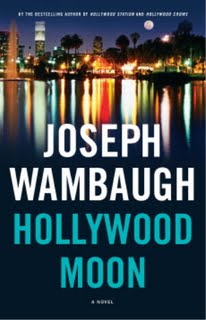 Take the regular roster of LAPD officers who work the mean streets of Hollywood – the neighborhood, not the state of mind. The surfer cops Flotsam and Jetsam. Nate Weiss, always ready with his SAG card. Toss in some newcomers to the patrol, like tough single mom/sergeant-to-be Dana Vaughn. Find the right balance of humor and heartbreak.
Take the regular roster of LAPD officers who work the mean streets of Hollywood – the neighborhood, not the state of mind. The surfer cops Flotsam and Jetsam. Nate Weiss, always ready with his SAG card. Toss in some newcomers to the patrol, like tough single mom/sergeant-to-be Dana Vaughn. Find the right balance of humor and heartbreak.
Add in some criminals, life-size opportunists and screw-ups. The lineup in Hollywood Moon includes a failed actor-turned-master-of-disguise putting in long days on an identity theft scam; the mastermind he lives in fear of, also his wife; a pair of runners wising up to the operation; and a borderline psychotic teenager desperate for an escape. Slowly turn up the heat. Stand back and watch things explode.
You have to season to taste. There’s too much of the surfers in this outing – a little of them goes a long way – but the heavies are the strongest yet. Wambaugh could write one of these books a month and I’d read it.
1Sometimes a successful formula can work against you. I had my first Mexican Coke recently. I didn’t know it when I bought it. I thought, “Cool! A glass bottle!” and only when I opened it did I notice the label was in Spanish. I didn’t like it. It tasted fine. It just didn’t take like Coke, which is what I wanted.
Wednesday, December 16, 2009
Movie: He Ran All The Way (1951)
The last John Garfield post started an interesting exchange with fine novelist/friend of the site Ed Gorman. Ed suggested that Garfield’s persona might not have worn as well as other noir stars because it can’t be easily reduced. Think of Robert Ryan and you think of that peculiar combination of rage and sorrow. Dana Andrews is melancholy. Bogart is coolness under pressure. Lee Marvin is menace.
As usual, Ed’s onto something. Garfield’s mercurial presence was used well in a number of strong films – The Postman Always Rings Twice, Body and Soul, Force of Evil – but not one that you could point to and say, “That is John Garfield.” Plus there’s something boyish about him. Ryan, Bogart, Marvin – these are men, fully grown and set in their ways. Garfield still seemed malleable. I meant it when I said Garfield cast a long shadow, because in an era with far too few men onscreen, Garfield is the best model we’ve got.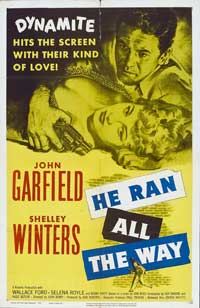 His youthful energy allowed him to play a role he was too old for in what would be his final film, He Ran All The Way. He’s a smalltime, slow-witted criminal still living with his mother (the pitiless Gladys George). After panicking during a payroll heist and killing a police officer, he picks up Shelley Winters, goes home with her, and takes her family hostage.
His youthful energy allowed him to play a role he was too old for in what would be his final film, He Ran All The Way. He’s a smalltime, slow-witted criminal still living with his mother (the pitiless Gladys George). After panicking during a payroll heist and killing a police officer, he picks up Shelley Winters, goes home with her, and takes her family hostage.
The movie is a forerunner of the home invasion genre that took root during the post-war suburban boom. Like other films of the type, there are moments that strain credulity. (“Rush him now! Take the gun!”) But it’s also charged with an uncommon mood of paranoia, even doom. Director John Berry and cinematographer James Wong Howe keep the camera uncomfortably close to Garfield’s desperate face, using scenery to trap him in the frame. The actor takes care of the rest, right up to the closing shot. It’s our last image of John Garfield. He died of a heart attack at age 39, haunted by charges of being a Communist sympathizer.
The latest issue of the Film Noir Foundation’s Noir City Sentinel includes a terrific article by Jake Hinkson that looks at He Ran All The Way as a blacklist case study. You can read it online now.
Upcoming: Noir City Northwest
Looks like I’ll be seeing He Ran All The Way again shortly, the way it was meant to be seen. The schedule for 2010’s Noir City Northwest is up. Eddie Muller’s dark carnival hits SIFF Cinema after its run in San Francisco.
This year’s theme is Lust & Larceny. It’s a doozy of a line-up. I’ve seen six of the fourteen films before, only one of them (Pitfall) on the big screen. I’m eager to catch the newly restored print of the crackling Cry Danger, while Rosemarie can’t wait for the aptly titled Larceny, starring John Payne and Dan Duryea as dandy grifters. Come that week in February you know where I’ll be, endeavoring to bring you the coverage you’ve come to expect.
Monday, December 14, 2009
Book: Print the Legend, by Craig McDonald (2010)
Other websites may be offering lists of 2009’s finest1, but around here we’re more forward thinking. Permit me instead to tease you with a word about one of the best books you’ll read next year2.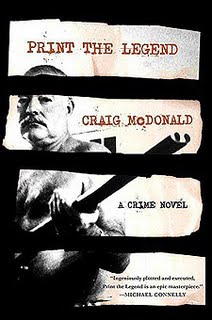 Print the Legend is the third novel by Craig McDonald featuring Hector Lassiter, the man who lives what he writes and writes what he lives. And it’s a full-on tour de force.
Print the Legend is the third novel by Craig McDonald featuring Hector Lassiter, the man who lives what he writes and writes what he lives. And it’s a full-on tour de force.
Hec’s longtime friend Ernest Hemingway is four years in the ground when Hec consents to address an Idaho conference devoted to Papa’s life and work. But Hec’s got more to reckon with than a speech. There are his own unsettled feelings about his compatriot. And the dogged efforts of a scholar intent on proving that Hemingway’s suicide was in fact a coldblooded murder committed by Papa’s wife Mary – a theory that Hec can’t easily dismiss. Plus Hec’s burgeoning affection for said scholar’s pregnant wife. Not to mention Mary Hemingway’s own plans for Papa’s legacy and Hec’s role in it. And above all, the twisted machinations of Donovan Creedy, the hack novelist, government operative and dirty tricks specialist with shades of E. Howard Hunt.
Not many authors would dare to write a missing chapter from Hem’s A Moveable Feast. Fewer would pull it off as McDonald does here. He then follows up with a beautifully structured section jumping between the POVs of his five major characters at a single treacherous meeting. Late in the book there’s an extended description of let’s say physical courage that Papa himself would approve of. Me, I went pale just reading it.
Print the Legend moves with the intensity of a fever dream, driven by Hec’s zeal for life. If the book has a weakness, it’s the notion that Creedy’s abstract plan has a hope in hell against the force of nature that is Hector Lassiter.
Why am I tormenting you with praise for a book that doesn’t come out until February? Because McDonald offers a few tantalizing hints of the next book in the series, set in 1958 Nashville, and that’s at least another year away. It’s only fair that we all suffer together.
1Don’t worry. Such a post is coming.
2Yeah, FTC, I got a review copy. Whatcha gonna do about it?
Thursday, December 10, 2009
On The Web: Crimespree Cinema
The gang over at Crimespree Cinema has asked some big names to contribute 5 favorites for 2009 – film, TV or DVD. Somehow I slipped through their defenses. My picks are up now.
Sort Of Related: The Fallen Sparrow (1943)/Nobody Lives Forever (1946)
John Garfield may not have the same level of recognition as noir icons like Humphrey Bogart and Robert Mitchum, and the rediscovery of other names from the era like Richard Conte has allowed him to get lost in the cracks. But Garfield’s shadow may extend the furthest. The type of character he often portrayed – streetwise but fundamentally decent, a boyish tough guy who could be tamed – is a standard today. Put it this way: alone among his contemporaries, Garfield could have played either Matt Damon’s role or Leonardo DiCaprio’s in The Departed, and been brought back to read for Mark Wahlberg’s into the bargain. Watching two lesser known Garfield films with serious crime fiction pedigrees brought home the potency of that persona.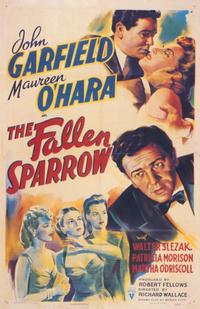 In The Fallen Sparrow, based on a novel by Dorothy B. Hughes (Ride the Pink Horse, In a Lonely Place), Garfield plays a veteran of the Spanish Civil War held prisoner by the Nazis. He’s freed in 1940 and returns to New York only to discover the Germans are still shadowing him while he delves into the murder of the childhood friend who delivered him from harm. The first third of the movie is rough sledding, a muddle with too many characters in a convoluted backstory. And may the gods of cinema take pity on you if you can’t figure out who the villain of the piece is. (Hint: The person it couldn’t be, because that’d be too obvious? Yeah, that’s who it is.)
In The Fallen Sparrow, based on a novel by Dorothy B. Hughes (Ride the Pink Horse, In a Lonely Place), Garfield plays a veteran of the Spanish Civil War held prisoner by the Nazis. He’s freed in 1940 and returns to New York only to discover the Germans are still shadowing him while he delves into the murder of the childhood friend who delivered him from harm. The first third of the movie is rough sledding, a muddle with too many characters in a convoluted backstory. And may the gods of cinema take pity on you if you can’t figure out who the villain of the piece is. (Hint: The person it couldn’t be, because that’d be too obvious? Yeah, that’s who it is.)
But Sparrow fascinates for several reasons. There’s a troika of interesting women, foremost among them Maureen O’Hara as an ice princess who only begrudgingly thaws. But it’s Garfield’s work as a proto-Manchurian Candidate, still suffering the effects of torture at the hands of his captors, that compels. The film’s MacGuffin is also just right, a mixture of nobility and stubbornness that suits Garfield to a T.
By comparison, Nobody Lives Forever is light entertainment. W.R. Burnett is credited as writing the original screenplay, but it’s adapted from a story serialized in Collier’s in 1943. Garfield is Nick Blake, recovered from his WWII service and ready to resume his grifting career. He lights out for the coast and sets his sights on a rich widow, but when he falls for her for real he has to deal his partners out.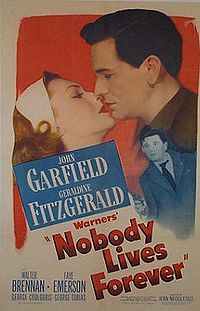 Nothing in Nobody is even remotely surprising, but the machinery is so finely assembled by Burnett and director Jean Negulesco that you’re happy to take a ride to a familiar destination if only to enjoy the scenery. George Coulouris chafes nicely as an aging con man who can’t accept that he’s no longer a pretty boy. Retro crush Faye Emerson is on hand as a bad girl, matched forehead for lovely forehead by Geraldine Fitzgerald as the pigeon who becomes a swan. But Garfield gives the enterprise life, charming as hell in rogue mode, touching when he goes soft on his mark. I’ve got some other Garfield films kicking around. It may be time to dig them out.
Nothing in Nobody is even remotely surprising, but the machinery is so finely assembled by Burnett and director Jean Negulesco that you’re happy to take a ride to a familiar destination if only to enjoy the scenery. George Coulouris chafes nicely as an aging con man who can’t accept that he’s no longer a pretty boy. Retro crush Faye Emerson is on hand as a bad girl, matched forehead for lovely forehead by Geraldine Fitzgerald as the pigeon who becomes a swan. But Garfield gives the enterprise life, charming as hell in rogue mode, touching when he goes soft on his mark. I’ve got some other Garfield films kicking around. It may be time to dig them out.
Wednesday, December 09, 2009
Book: Ticket to Ride, by Ed Gorman (2009)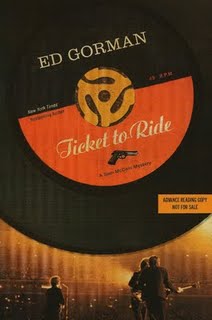 I’ve read quite a few books by Ed Gorman, but somehow the Sam McCain series got by me. So naturally I’m starting with the newest entry, which is also possibly the last. Still, better late than never.
I’ve read quite a few books by Ed Gorman, but somehow the Sam McCain series got by me. So naturally I’m starting with the newest entry, which is also possibly the last. Still, better late than never.
Sam is a lawyer/investigator in Black River Falls, Iowa. It’s 1965. The local minister is burning Beatles records and people are starting to pay attention to the conflict in Vietnam. Some, like Sam, are doing more. They’re organizing protests, incurring the wrath of more conservative friends and neighbors. Shortly after one such rally goes awry, there’s a murder. As far as the sheriff is concerned it’s tied to the demonstration, but Sam unearths connections to a death that rocked the town several years before.
It’s a Gorman novel, so you get a well-turned plot, deft pop culture references, and sharp observations on small town life. You also get characters who don’t conform to expectations. The golden boy activist railroaded into jail? He’s something of an operator. The die-hard patriot ready to tar and feather is also a grieving father. Then there’s Sam himself, aware of all these incongruities as he struggles to do the right thing.
Here’s Ed in conversation with Tom Piccirilli about Ticket to Ride, the earlier Sam McCain books, and other sundry matters.
Saturday, December 05, 2009
Book: Losers Live Longer, by Russell Atwood (2009)
Exhibit A: The rare horizontal cover.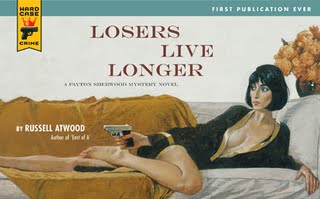 Like I’m not gonna read that.
Like I’m not gonna read that.
Exhibit B is the setting in Manhattan’s East Village, specifically a few blocks where I’ve spent my share of time. But what cinched it for me was this review by James Reasoner. When he called this Hard Case Crime book “one of the best private eye novels of recent years,” I stopped in at Seattle Mystery Bookshop and picked it up that day.
Payton Sherwood is the P.I. in question. Down-at-heel (for a few chapters literally), he’s happy to be asked by a legendary retired operative to pitch in for a few hours on a case. When the senior shamus turns up dead on his doorstep, Payton decides to follow through on the job – even though he has no idea what it is. Before his long day is through, he’ll tangle with porn kingpins, indie filmmakers, and, of course, beautiful women. It’s old school pulp served up with a sharp contemporary sensibility. Fast, ferocious and authentically funny. Don’t miss it.
DVD: Edgar G. Ulmer: The Man Offscreen
Cult director Ulmer was the king of Poverty Row, a man who could stretch a budget to the breaking point and, with 1945’s Detour, created true dark magic. This 2004 documentary reveals that the man who made something out of nothing in his work did the same with his own life story. Stylishly shot, featuring comments from collaborators (Ann Savage, William Schallert) and admirers (Wim Wenders, Joe Dante, John Landis). The best stuff comes late as John Saxon and Peter Marshall, costars of Ulmer’s last film The Cavern, bicker in the back of a convertible before a rear-projection screen.
As an extra you get an entire Ulmer movie, 1943’s Isle of Forgotten Sins. It’s the South Seas by way of North Hollywood, the ocean-going scenes shot with models and the deep sea diving done by marionettes. Not good by any stretch, but strangely compelling and, as always with Ulmer, done with ingenuity.
Tuesday, December 01, 2009
Movies: A Phil Karlson Thanksgiving
The Phil Karlson Thanksgiving Weekend wasn’t planned. It was an act of necessity.
The problem is I’d become obsessed with that clip of John Payne and others performing “The Girlfriend of the Whirling Dervish” in Garden of the Moon. (Have you watched it yet? Go ahead. I’ll wait.) After repeated viewings of an impossibly young John Payne deftly tossing off Johnny Mercer’s lyrics, I needed to restore to my memory the older version. His face collapsed yet even more magnetic. In trouble and sinking deeper. The noir John Payne. That actor’s best collaborator was ex-prop man turned director Karlson. Time to revisit their finest hour.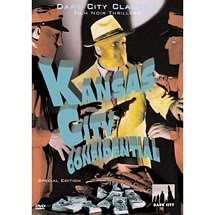 In Kansas City Confidential (1952), Payne plays an ex-con whose efforts to go straight mean nothing when he becomes the unintentional fall guy in a daring robbery. The simmering fury when he’s sprung from jail knowing that no one legit will ever trust him again is scorching. That bone-deep sense of betrayal, of hard work going for naught, charges the rest of the film, which despite the title is set mostly south of the border. Karlson as always keeps the action taut, and there’s the added bonus of what has to be the most badass crew in the annals of noir: Jack Elam, Lee Van Cleef, and Neville Brand.
In Kansas City Confidential (1952), Payne plays an ex-con whose efforts to go straight mean nothing when he becomes the unintentional fall guy in a daring robbery. The simmering fury when he’s sprung from jail knowing that no one legit will ever trust him again is scorching. That bone-deep sense of betrayal, of hard work going for naught, charges the rest of the film, which despite the title is set mostly south of the border. Karlson as always keeps the action taut, and there’s the added bonus of what has to be the most badass crew in the annals of noir: Jack Elam, Lee Van Cleef, and Neville Brand.
Appetite whetted, I craved more. And had it on hand, thanks to the new Columbia Pictures Film Noir Classics Collection. I’d wanted to see 5 Against the House (1955) for years, and not just for Karlson. It’s based on a Jack Finney story, adapted by Stirling Silliphant (In the Heat of the Night) and William Bowers (Cry Danger, The Mob). Imagine my surprise to discover it’s the rare Karlson film that’s a total misfire.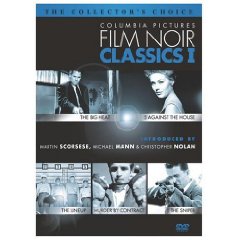 5ATH begins as a tiresome college comedy then becomes a heavy-handed survey of the problems faced by returning Korean War vets taking advantage of the G.I. Bill before settling into a heist groove. The “perfect plan” posited by these aging students would be ridiculous under any circumstances, but on the heels of the ingenious scheme cooked up in Kansas City Confidential it’s downright embarrassing. There’s nice work by Brian Keith as the most damaged vet and a good climax set in an automated parking garage in Reno, but little else.
5ATH begins as a tiresome college comedy then becomes a heavy-handed survey of the problems faced by returning Korean War vets taking advantage of the G.I. Bill before settling into a heist groove. The “perfect plan” posited by these aging students would be ridiculous under any circumstances, but on the heels of the ingenious scheme cooked up in Kansas City Confidential it’s downright embarrassing. There’s nice work by Brian Keith as the most damaged vet and a good climax set in an automated parking garage in Reno, but little else.
ASIDE: Also in the Columbia collection is a superior Silliphant-scripted drama, 1958’s The Lineup (reviewed here), that features one of the greatest recent commentary tracks. My friend Eddie Muller and novelist James Ellroy tag-team on this one, Eddie providing a native San Franciscan’s view while Ellroy gives full vent to his obsessions. Eddie gave me a heads up after they recorded the track, saying, “It’s a wild one.” It lives up to that billing.
In the immortal words of Homer Simpson, you can’t go this far and not go further. On to the Karlson films parked on the DVR.
I’d seen 1955’s The Phenix City Story, but never with the reportorial prologue including interviews with several of the people involved in this true story. This segment made it easier to get scenes of still-shocking violence past the censors. Without it the movie opens with a haggard roadhouse number, ‘The Phenix City Blues,’ that swiftly presents the low-rent reality of life in an Alabama town choking on the vice aimed at soldiers in neighboring Fort Benning. Karlson and Georges Simenon make a natural match in The Brothers Rico (1957), with Richard Conte as an erstwhile Mafia accountant who thinks he’s made a clean break to become a cleaner, only to find himself doing the Organization’s bidding when his siblings go astray. With a dandy performance by Harry Bellaver as a local kingpin who orders hits and dinner in the same breath. They’re both tough-minded movies with a view of mobsters similar to the one articulated in Josh Bazell’s novel Beat the Reaper:
Proudly ignorant, personally repellent, absolutely convinced that their willingness to hire someone to beat money out of someone who worked for a living constitutes some kind of genius and an adherence to a proud tradition.
99 River Street, a John Payne/Phil Karlson film that screened at Noir City 2007, is currently available on Hulu and Fancast. You could be watching it right now! Here’s Ivan’s take at Thrilling Days of Yesteryear. I look at Karlson’s final film Framed here.